Projects that funded the research work:
co-operating neurologists Péter HARCOS*1, Miklós TÁRCZY*2, Annamária TAKÁCS*3.
*1: Szt. Imre Hospital, Budapest
*2: Semmelweis Univeristy of Medicine, Budapest, ceased in 1998.
*3: Semmelweis Univeristy of Budapest
The common problems influencing the motor system of PD patients are: tremor at rest, rigidity, hypokinesia and postural instability. The manifestation of these impairments is very weak, hardly noticeable visually in the early phase.
For a more effective treatment clinicians require a standardised objective staging of PD patients. Our investigations aim at finding the appropriate measurement methods to fulfil the needs of neurologists/clinicians.
The persons we tested were asked to perform the movement patterns below as fast as they could:
Tapping: Patients put their hands on the table,
10 mm diameter markers are attached to the middle phalanges of their fingers.
Patients lift 8 of their fingers (thumbs remain on the table) and then
hit the table with their fingertips in the following order: little-, ring-,
middle- and index finger. This mimics the piano-playing movement.
Twiddling: Patients twiddle their hands in front of their trunks. Forearms are nearly horizontal. Markers with 25 mm diameter are attached to their forearms, approximately 20 cm far from their carpal bones.
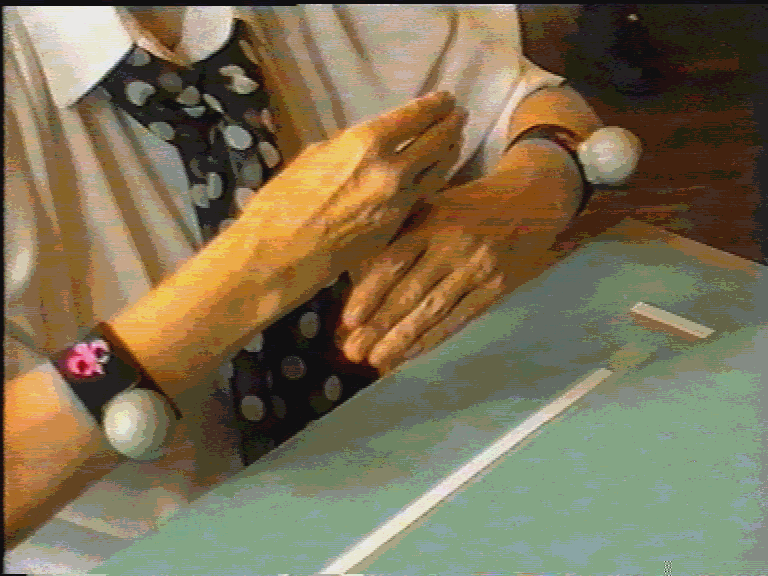
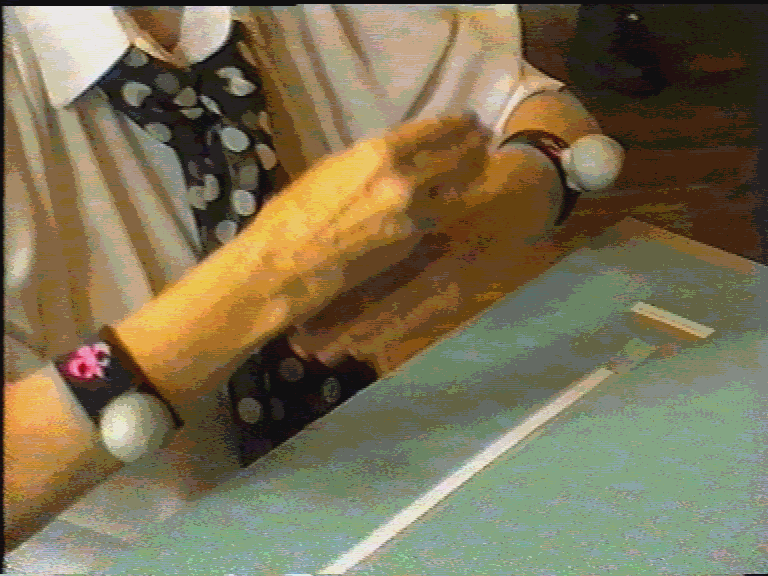
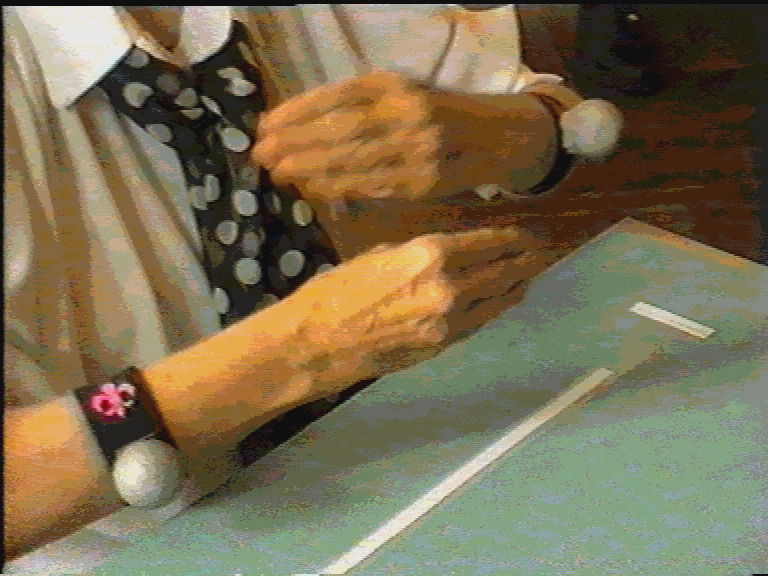
The twiddling movement
Pinching and circling: This is performed in 6 phases. The 4 single hand movements are: pinching with the right hand, pinching with the left hand, circling with the right hand, circling with the left hand. The 2 parallel movements are: pinching with the right hand while circling with the left hand and pinching with the left hand while circling with the right hand. Markers with 10 mm diameter are attached to the middle phalanges of the index fingers.
Pinching movement: The forearm is in vertical position, little-, ring- and middle fingers touch the palm. The patient moves his/her index finger: touches the thumb, then lifts the index finger and then touches the thumb again.
Circling movement: The forearm is in horizontal position, the index finger is stretched. The forearm circles around the superficies of an imaginary cone, the elbow is supposed to remain in nearly the same position.
The pinching and circling movement
Tap heel on ground: The person is sitting on a chair,
lifts his/her foot above the floor by approximately 10 cm and then hits
the floor with the foot again.
Tap heel on ground.
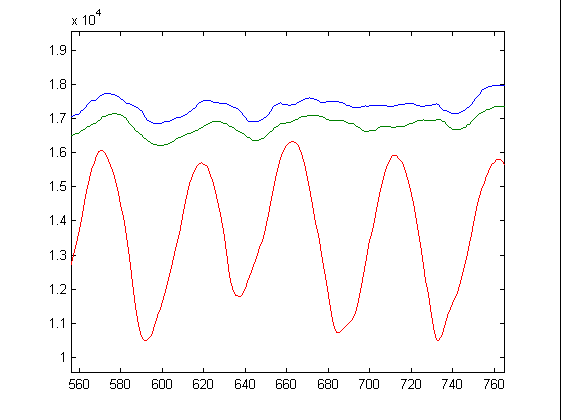
The pinching and circling movement of a Parkinsonian
patient. Red line: circling, blue and green lines: pinching.

The pinching and circling movement of a young healthy
subject. Red line: circling, blue and green lines: pinching.
Behavior (movement patterns) of animals has been used for a long time in medical sciences as an indicator of the "system state" i.e. of the influence of a particular treatment upon the animal's condition. Until recently the evaluation of such behavior was done visually, by the experimenter, without any possibility of an objective measurement procedure. The introduction of the passive marker based motion analysis in controlled laboratory conditions led to the reproducible generation of observables that can be quantified and further processed. The selection of an adequate model and the appropriate signal processing constitutes the major problem. Animal behavior should be described in two levels requiring two models. The quantitative (low level) model is used to describe the physical movement. The psychophysical state of an animal can be characterized with the help of the qualitative (high level) model that is to be established with the involvement of medical experts.
Rats in tubelike cages with markers.
Robot Movement Analysis: Pose Tracking for Robotised Peg-Hole Insertion
co-operating mechanical engineers: András TÓTH,
Gusztáv ARZ (Technical University of Budapest)
The aim of the test set-up was to track the movement of the peg attached
to the robot arm through a Remote Centre of Compliance (RCC) device with
sub-µm resolution. The high resolution is necessary since dynamic
effects like stick-slip motion have to be observed at small peg-hole clearances
(< 0.1-0.2 mm). Motion analysers specify resolution and accuracy in
percentage of their field of view. The resolution of the PRIMAS analyser
is 1:6000 while its accuracy is 1:2000, when average size (containing 10-12
lines) marker images are used. Both resolution and accuracy increases with
marker image size. The necesary resolution and accuracy could be reached
by using a pattern of markers extending well beyond the field of view of
the camera. The motion analyser sees only a few markers at a time thus
the marker images can be unusually big, covering several thousands of pixels
each. The position of the peg is determined by knowing the distances between
the markers in the marker pattern with very high accuracy.
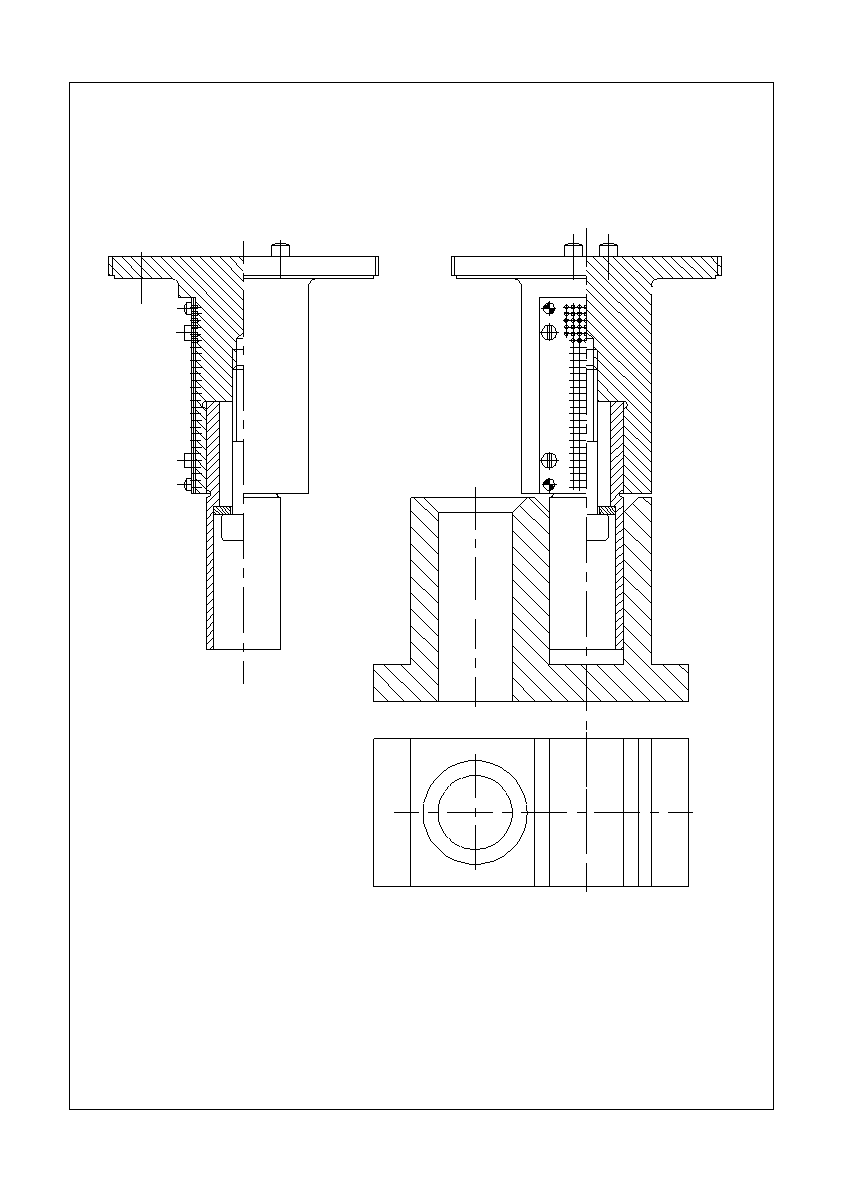
Peg-hole test-rig, the marker pattern is attached to
the peg.
Moving peg and the marker pattern seen by the PRIMAS motion analyser. robot.avi
co-operating dentist: András MALATINSZKY
The aim is to test the chewing motion of persons in order to analyse the appropriateness of prosthesis.
DISSERTATIONS
Centre Estimation in Marker Based Motion Analysis. PhD
Theses, 1993. 120 pages. TUB-TR-93-EE04, ISBN 963-421-509-2.
JOURNAL PAPERS IN ENGLISH
In foreign journals
Monos, E. - L.Gyöngy - Á.Jobbágy: A novel method for motion analysis of animals exposed to gravitational load. Journal of Physiology, London, 1996. Vol. 491P, pp. 75-76.
Á.Jobbágy - E.H.Furnée: Marker Centre Estimation Algorithms In CCD Camera Based Motion Analysis. Medical & Biological Engineering & Computing, Vol. 32. Nr. 1. Jan. 1994. pp. 85-91..
E.H.Furnée - Á.Jobbágy: Precision 3-D Motion Analysis System For Real-time Applications. Invited paper, Microprocessors and Microsystems, Vol.17., Nr.4. May 1993. pp. 223-231.
Á.Jobbágy - E.H.Furnée: New Marker Centre
Estimation Algorithms Of High Accuracy In Motion Analysis. Periodica
Polytechnika, Ser. Electrical Engineering Vol. 36. NOS. 3-4, pp. 249-258.
1992.
Thomas, Júlia, Soós, Gábor, Jobbágy, Ákos, Furnée, Hans: Two levels of image processing in passive marker-based motion analysers. Conf. proc. of EMBEC99, 4-7 November, Vienna, pp. 848-849
Ákos Jobbágy, E.Hans Furnée, Balázs Romhányi, László Gyöngy, Gábor Soós: Resolution and Accuracy of Passive Marker-based Motion Analysis. 8th International IMEKO TC-13 Conference on Measurement in Clinical Medicine, 16 - 19 September, 1998, Dubrovnik, Croatia, pp. 2.3. - 2.6.
Furnée, E.H., Á. Jobbágy, J. C. Sabel, H.L.J. van Veenendaal, F. Martin, D.C.W.G. Andriessen: Marker-referred movement measurement with grey-scale coordinate extraction for high-resolution real-time 3D at 100 Hz. J.S. Walton (ed.) Proc. of the SPIE Symposium on Image based motion analysis SPIEís 42nd Annual Meeting, 27 July - 1 August 1997, San Diego, CA USA. SPIE3173857.
Jobbágy, Á., L. Gyöngy and E. Monos: Evaluating Movement Patterns of Rats - The Measurement Theoretical Point of View. Proc. of the IEEE Instrumentation and Measurement Technology Conference, Brussels, Belgium, 1996. June 4-6. pp. 101-105.
Jobbágy, Á., L. Gyöngy, E.H. Furnée: Biomedical Applications of a High-Precision Passive Marker Based Motion Analyser. The 10th Nordic-Baltic Conference on Biomedical Engineering, June 9-13, 1996. Tampere, Finland. Proceedings in: Medical & Biological Engineering & Computing (UK), Vol. 34, Supplement 1, Part 1, pp. 331-332.
Jobbágy, Á., P. Harcos and M. Tárczy: Measurement Environment for Diagnosing the Parkinsonís Disease. 18th Annual International Conference of the IEEE Engineering in Medicine and Biology Society, 31 October - 3 November, Amsterdam, The Netherlands. Paper no. 2.6.3., the proceedings on CD-ROM.
Á.Jobbágy - L.Gyöngy - F.Martin - Gy.Ábrahám: Video Signal Processing with High Resolution in Passive Marker Based Motion Analysis.Proceedings of the XVth Congress of the International Society of Biomechanics, July 1995 Jyväskylä, Finland. pp. 436-437.
Jobbágy, Á., L. Gyöngy, E. Monos, P. Harcos: Biomedical applications of a precision motion analysis system. Proceedings of the 7th International IMEKO TC-13 Conference on Measurement in Clinical Medicine: Model Based Biomeasurements, Stará Lesná, Slovakia, pp. 401-403.
Jobbágy, Á., L. Gyöngy, T. Dabóczi: Increasing the accuracy of a TV based motion analysis system. Proceedings of the 7th International IMEKO TC-13 Conference on Measurement in Clinical Medicine: Model Based Biomeasurements, Stará Lesná, Slovakia, pp. 385-387.
Jobbágy, Á., L. Gyöngy, Gy. Ábrahám, F. Martin: Processing of images in passive marker based motion analysis. Proceedings of COMBIO '95, Kecskemét, Hungary. KFKI Preprint/Report Series, 1995, Vol. 14. Ch.33, No. PtM&H, pp. I32-I36, ed. I. Erényi.
Jobbágy, Á. - E. H. Furnée: PRIMAS.EC - Precision Real-time Image-based Motion Analysis System at Economical Cost. In: Studies in Health Technology and Informatics, Eds.: Laires, M.F., Ladeira, M.J., Christensen, J.P. ,1995, Vol. 24, Ch. 106, pp. 363-364. IOS Press, Amsterdam. Proc. of the Conf. on Health in the New Communications Age - Health Care Telematics for the 21st Century. Lisbon, 6-10 Dec., 1994.
Á.Jobbágy - E.H.Furnée - H.L.J. van Veenendaal: Centre estimation of circles based on binarised images. Conf. Proc. of the XIIIth World Congress of IMEKO, 1994 Torino pp. 2534-2539.
Furnée, E.H. - Sabel, J.C. - van Veenendaal, H.L.J. - Á.Jobbágy: 3 - D Performance Characterization In Motion Analysis Systems: An Example.European Gait Analysis Symposium, 1992 Zürich p. 280-283.
Á.Jobbágy - E.H.Furnée - H.L.J. van Veenendaal:
New
Algorithms For Real-Time Marker Centre Estimation In Motion Analysis.
Conf.Proc.
of 2nd International Conf. On DSP Applications and Technology, 1991 Berlin
p. 489-498.
J. Thomas - Á. Jobbágy - E.H. Furnée - F. Fogarasi: Data Processing in Marker Based Motion Analysis. Proc. INTCOM98, Miskolc, 1998. pp. 186-192.
Á. Jobbágy - E. H. Furnée - Zs. Lóránt - A. Tóth - B. Romhányi - J. Thomas: Image Processing in Passive Marker -Based Motion Analysers. Proc. First Conf. on Mechanical Engineering, Springer Hungarica, 1998, pp. 830-834.
Jobbágy, Á., E.H. Furnée, L. Gyöngy, P. Harcos, Zs. Lóránt: Movement pattern analysis of neurological diseases. TEMPUS S_JEP, 07759-94 MODIFY SYMPOSIUM, Budapest and Miskolc, 6-10 May, 1997.
Jobbágy, Á., L.Gyöngy, E.Monos, E.H.Furnée: Evaluating the Movement Patterns of Rats Using the PRIMAS Motion Analyzer. A XX. Neumann Kollokvium Kiadványa (szerk. Kozmann György), 1996. november 14-16, Veszprém. 73-76. old.
Monos, E., L. Gyöngy, Á. Jobbágy: New method for the evaluation of circadial movement of rats with gravitational load. Book of abstracts of the LXth Conference of the Hungarian Society of Physiology Budapest, 1995. (in Hungarian) p. 126.
Á.Jobbágy - E.H.Furnée - Gy.Ábrahám - F.Martin: Centre Estimation of Distorted Binarised Marker Images. Conf. Proc. of m P '94, The Eighth International Conference On Microprocessing and Microcomputing 1994 Budapest pp.605-614.
Á.Jobbágy: Resolution and Accuracy Of Motion Analysis
Using CCD Based Cameras and Reflecting Markers. Conf. Proc.
of m P '92, The Seventh International Conference
On Microprocessing and Microcomputing 1992 Budapest pp. 471-478.
Thomas, J., - Soós, G. - Jobbágy, Á. - Furnée, H.: Az adatfeldolgozás két szintje a passzív markerbázisú mozgásanalizátorokban. Kórház- és Orvostechnika, XXXVII. évfolyam 6. szám, 1999. november - december, 243- 249. oldal.
Jobbágy Á.: Passzív markerbázisú
mozgásanalízis. (Passive marker based motion analysis) Mérés-
és Automatika, 1995. 42/2, pp. 32-33.
Thomas, Júlia, Soós, Gábor, Jobbágy, Ákos, Furnée, Hans: Az adatfeldolgozás két szintje a passzív marker-bázisú mozgásanalizátorokban. In Hungarian. (Two levels of image processing in passive marker-based motion analysers.) Conf. proc. of BUDAMED99, 12-14 September, Budapest, pp. 53-55. The paper is accepted for publication in the Hungarian journal Kórház és Orvostechnika.
Lóránt Zs., Gyöngy L., Jobbágy Á., Monos E.: Patkányokon elhelyezett marker-elrendezések felismerése. Konferencia kiadvány, XXI. Neumann Kollokvium és Kiállítás, Veszprém, 1998. pp. 49-52.
Jobbágy, Á.: A markerbázisú mozgásanalízis
pontosságának növelése. (Increasing the accuracy
of marker-based motion analysis) Konferencia kiadvány, MEDICOMP'92
Kollokvium Szeged, 1992. pp. 156-163.
Jobbágy, Á. - E.H.Furnée: Centre estimation in marker based motion analysis. Deliverable #1 to DG XIII of CEC, according to COPERNICUS project PRIMAS.EC (CIPA3510CT937845) Sept. 1994.
Á.Jobbágy: The Study of Resolution and Accuracy
in TV-based Motion Analysis Using Simulation Programs. Delft
University of Technology, Fac. Applied Physics, 1991. dec. Technical report.
Jobbágy, Á. - Gyöngy, L. - Ábrahám,
Gy. - Martin, F.: Új algoritmusok és módszerek
alkalmazása passzív markerek követésén
alapuló mozgásanalizáló rendszerek pontosságának
növelésére. (Application of new algorithms and methods
to increase the accuracy of passive marker based motion analysers Kutatási
részjelentés a 04057 93 12 13 nyilvántartási
számú OMFB szerzõdéshez, 1994.